Tax season is here again. Being organized can make the process smoother and help you avoid missing key deductions or credits.
Here’s an updated checklist to guide you through your 2024 tax return, tailored for clients of Taylor & Associates Financial Services.
1. Retrieve Last Year’s Tax Return
Start by locating your 2023 tax return. It helps identify the forms you filed, deductions, and credits you claimed.
- New Clients: Please provide your 2023 tax return to help us understand your tax history.
- Existing Clients: We already have your prior return on file.
If you can’t find your return, we can assist in requesting a simple transcript from the IRS, or you can request one for free. A full return copy costs $30 from the IRS and may take some time to process.
2. Confirm Your Filing Status
Your filing status affects your tax bracket and eligibility for certain deductions and credits. The five statuses are:
- Single
- Married Filing Jointly
- Married Filing Separately
- Head of Household
- Qualifying Widow(er) with Dependent Child
Life changes like marriage, divorce, or having a child may impact your status. Share any updates so we can ensure accurate filing.
3. Stay Informed About Tax Law Changes
Key changes for the 2024 tax year include:
- Standard Deduction Increase: $14,600 for single filers, $29,200 for married couples filing jointly.
- Retirement Contributions: Higher contribution limits for retirement accounts.
- 1099-K Reporting Threshold: Payments over $5,000 via platforms like PayPal or Venmo must be reported.
We stay updated on tax laws to ensure our tax filing service reflects the latest changes.
4. Reflect on Life Changes
Life events can influence your tax situation:
- New Child: Eligibility for the Child Tax Credit.
- Home Purchase: Potential deductions for mortgage interest and property taxes.
- Education Expenses: Possible deductions for tuition payments or student loan interest.
For retirees:
- Social Security Benefits: Up to 85% may be taxable depending on income.
- Required Minimum Distributions (RMDs): Required if you’re 73 or older.
- Healthcare Costs: Deductible if they exceed 7.5% of your adjusted gross income.
5. Maximize Retirement Contributions
Contributing to retirement accounts can reduce taxable income. For 2024, contributions can be made until April 15, 2025.
- Catch-Up Contributions: Available if you’re 50 or older.
- Qualified Charitable Distributions (QCDs): If you’re 70½ or older, you can donate up to $100,000 directly from an IRA to a qualified charity, reducing taxable income.
6. Gather Essential Documents
Organize the following documents for efficient tax preparation:
- Personal Info: Social Security numbers and bank account details.
- Income Documents: W-2s, 1099s, Social Security statements, pension income, and other income records.
- Deduction Records: Charitable donations, medical expenses, mortgage interest, and state/local tax payments.
- Tax Payments: Proof of any estimated tax payments made during the year.
7. Work with Your CPA
A professional CPA offers more than tax filing—personalized advice, strategic planning, and peace of mind. We’re here to ensure accuracy, optimize deductions, and provide year-round support.
The Bottom Line
Staying organized and proactive makes tax season manageable. At Taylor & Associates Financial Services, we’re here to help you file accurately and efficiently. Check out our tax filing service and contact us when you’re ready to get started on your 2024 tax return.
